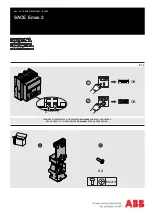
17
O P ER AT I O N
Electrical operation
To operate the breaker electrically, control power
must be available. The section entitled Racking
describes the application of control power through
the secondary disconnect when the breaker is in the
test and connect positions. Optional test jumpers
and test cabinets to connect control power to a
withdrawn circuit breaker are available (contact
your local ABB sales office for details).
1. Inspect initial state of the breaker to determine
the operations available:
a. Close/open indicator
b. Closing spring charged/discharged indicator
c. Circuit breaker position test or connect
(or control power applied externally,
if withdrawn)
2. Energize control power source.
a. Charging motor energizes. Charge time is
approximately 8–10 seconds (at nominal
voltage). Closing spring charged/ discharged
indicator shows “charged.”
b. Breaker is ready to perform C-O operation.
3. Close breaker using manual close push button
or by electrical signal to the close coil (after close
operation, the motor charges unless control
power is removed).
a. Close coil closes breaker. Close/open
indicator changes to “closed.” Closing spring
charged/discharged indicator changes to
“discharged.” Charging motor energizes.
Charge time is approximately 8–10 seconds
(at nominal voltage). Closing spring charged/
discharged indicator shows “charged.”
b. Breaker is ready to perform O-C-O operation.
4. Open breaker using manual open push button
or by electrical signal to the open coil.
a. Open coil opens breaker. Close/open indicator
changes to “open.” Closing spring charged/
discharged indicator remains “charged.”
Closing spring charged/discharged indicator
changes to “discharged.”
b. Breaker is ready to perform C-O operation.
5. Breaker is ready to continue operations,
returning to step 3 above, until the source of the
control power is deactivated. Once control power
is removed from the charging motor, the closing
spring will not recharge after a close operation.
















































